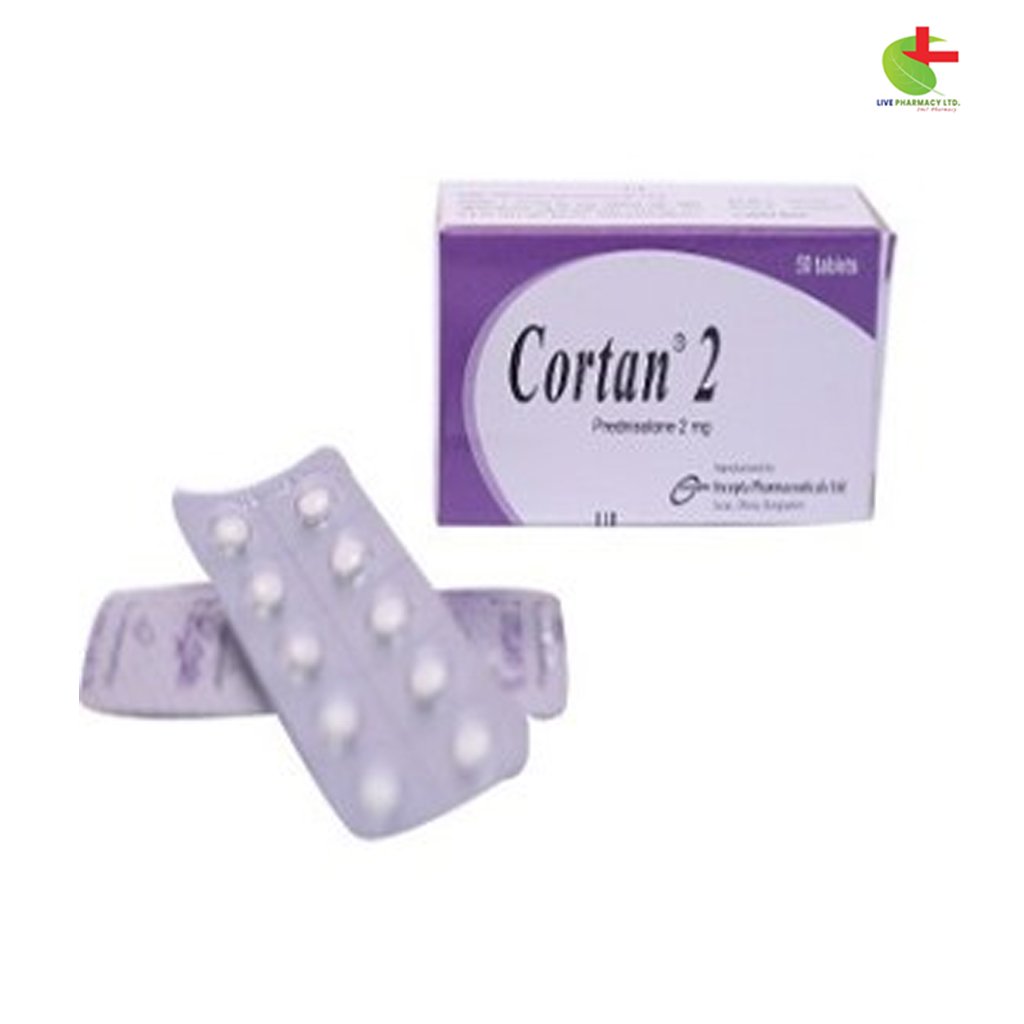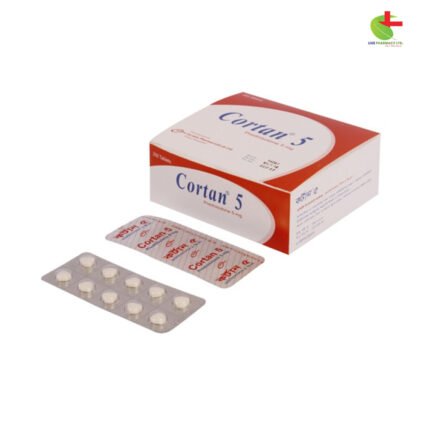Cortan 2
8.00৳ Strip
- Cortan is a synthetic glucocorticoid used for various conditions, including rheumatic disorders and endocrine issues.
- It effectively reduces inflammation by inhibiting the production of inflammatory mediators.
- Administered in precise dosages, it is essential for managing conditions like asthma, nephrotic syndrome, and autoimmune disorders.
- Always consult a healthcare professional for appropriate use and monitoring.
 Brand
Brand
|
Incepta Pharmaceuticals Ltd |
|---|---|
 Generics
Generics
|
Prednisolone |
 Type
Type
|
Tablet |
Indications
Cortan is prescribed for a variety of conditions, including:
- Rheumatic Disorders: Psoriatic arthritis, rheumatoid arthritis, juvenile rheumatoid arthritis, ankylosing spondylitis, acute and subacute bursitis, acute nonspecific tenosynovitis, acute gouty arthritis, and post-traumatic osteoarthritis.
- Endocrine Disorders: Primary or secondary adrenocortical insufficiency, congenital adrenal hyperplasia, nonsuppurative thyroiditis, and hypercalcemia related to cancer.
- Dermatologic Diseases: Pemphigus, bullous dermatitis herpetiformis, severe erythema multiforme, exfoliative dermatitis, mycosis fungoides, and severe psoriasis.
- Allergic States: Seasonal or perennial allergic rhinitis, bronchial asthma, contact dermatitis, atopic dermatitis, serum sickness, and drug hypersensitivity reactions.
- Respiratory Diseases: Symptomatic sarcoidosis, berylliosis, and fulminant aspiration pneumonitis.
- Hematologic Disorders: Idiopathic thrombocytopenic purpura, secondary thrombocytopenia, acquired (autoimmune) hemolytic anemia, and erythroblastopenia (RBC anemia).
- Edematous States: To promote diuresis or reduce proteinuria in nephrotic syndrome (without uremia), whether idiopathic or due to lupus erythematosus.
- Gastrointestinal Diseases: Ulcerative colitis and regional enteritis.
Always consult a registered healthcare professional before using this medication.
Pharmacology
Cortan contains prednisolone, a synthetic adrenocortical agent with strong glucocorticoid effects. It inhibits the enzyme phospholipase A2, which plays a key role in producing various inflammatory mediators, including leukotrienes and prostaglandins. Prednisolone is efficiently absorbed from the gastrointestinal tract following oral administration and is 70-90% protein-bound in plasma. Its elimination half-life ranges from 2 to 4 hours, and it is primarily metabolized in the liver and excreted through urine.
Dosage & Administration
Adults:
- Nephrotic Syndrome:
- Initial: 2 mg/kg/day (maximum 80 mg/day) in divided doses until protein-free urine for 3 consecutive days (up to 28 days).
- Maintenance: 0.5 to 1 mg/kg every other day for 3 to 6 months.
- Anti-inflammatory: 5 to 60 mg daily in divided doses.
- Acute Asthma: 40-60 mg/day, either as a single dose or divided every 12 hours for 3-10 days.
- Allergic Conditions: Follow a gradual tapering schedule starting with 10 mg before breakfast on Day 1, then reducing doses progressively.
Pediatric:
- Asthma: Dosages vary by age, from 10 mg every 12 hours for infants to 40 mg for adolescents.
- Anti-inflammatory & Immunosuppression: 0.05 to 2 mg/kg/day divided into 1 to 4 doses.
Always consult a registered healthcare professional before using this medication.
Interactions
Cortan’s effectiveness may be diminished by aminoglutethimide, antacids, barbiturates, carbamazepine, griseofulvin, mitotane, phenylbutazone, phenytoin, primidone, and rifampin. It can lead to decreased potassium levels, which may cause cardiac arrhythmias when combined with digitalis. Immunization should be approached cautiously.
Contraindications
Cortan should not be used in systemic infections unless appropriate anti-infective therapy is initiated. It is contraindicated in individuals with hypersensitivity to any ingredient and in cases of ocular herpes simplex due to the risk of perforation.
Side Effects
Common side effects may include increased appetite, indigestion, nervousness, and restlessness. Less common effects can include changes in skin pigmentation, dizziness, facial flushing, hiccups, increased sweating, and vertigo.
Pregnancy & Lactation
Cortan is not recommended during pregnancy unless absolutely necessary. It should only be used if the potential benefits to the mother outweigh the risks to the fetus. Corticosteroids can appear in breast milk and may affect growth or disrupt endogenous corticosteroid production.
Precautions & Warnings
Caution is advised for individuals with diabetes, hypertension, psychological disorders, osteoporosis, post-menopausal status, pregnancy, and chronic nephritis. Long-term use may lead to Cushing’s syndrome, hyperglycemia, muscle weakness, increased infection risk, delayed wound healing, and psychological disturbances.
Overdose Effects
Symptoms of overdose typically arise after prolonged use of high doses. Treatment is symptomatic, and the prednisolone dosage should be tapered gradually.
Therapeutic Class
Glucocorticoids
Storage Conditions
Store in a cool, dry place, protected from light. Keep out of reach of children.













Reviews
There are no reviews yet.